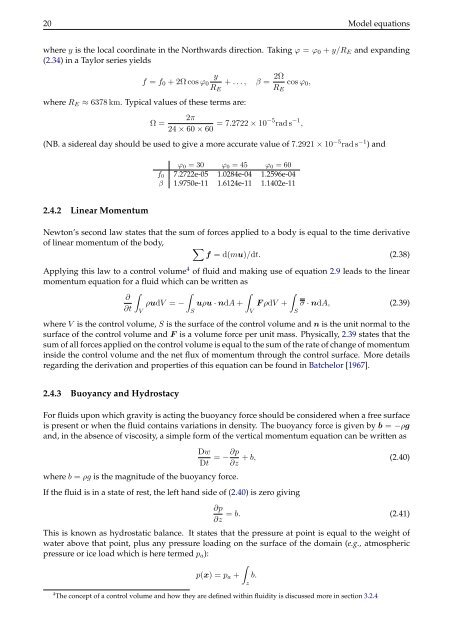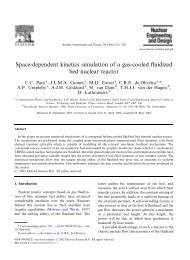Chapter 8 Configuring Fluidity - The Applied Modelling and ...
Chapter 8 Configuring Fluidity - The Applied Modelling and ...
Chapter 8 Configuring Fluidity - The Applied Modelling and ...
Create successful ePaper yourself
Turn your PDF publications into a flip-book with our unique Google optimized e-Paper software.
20 Model equations<br />
where y is the local coordinate in the Northwards direction. Taking ϕ = ϕ0 + y/RE <strong>and</strong> exp<strong>and</strong>ing<br />
(2.34) in a Taylor series yields<br />
f = f0 + 2Ω cos ϕ0<br />
y<br />
RE<br />
where RE ≈ 6378 km. Typical values of these terms are:<br />
Ω =<br />
+ . . . , β = 2Ω<br />
cos ϕ0,<br />
RE<br />
2π<br />
24 × 60 × 60 = 7.2722 × 10−5 rad s −1 ,<br />
(NB. a sidereal day should be used to give a more accurate value of 7.2921 × 10 −5 rad s −1 ) <strong>and</strong><br />
2.4.2 Linear Momentum<br />
ϕ0 = 30 ϕ0 = 45 ϕ0 = 60<br />
f0 7.2722e-05 1.0284e-04 1.2596e-04<br />
β 1.9750e-11 1.6124e-11 1.1402e-11<br />
Newton’s second law states that the sum of forces applied to a body is equal to the time derivative<br />
of linear momentum of the body,<br />
� f = d(mu)/dt. (2.38)<br />
Applying this law to a control volume4 of fluid <strong>and</strong> making use of equation 2.9 leads to the linear<br />
momentum equation for a fluid which can be written as<br />
�<br />
�<br />
� �<br />
∂<br />
ρudV = − uρu · ndA + F ρdV + σ · ndA, (2.39)<br />
∂t<br />
S<br />
V<br />
S<br />
V<br />
where V is the control volume, S is the surface of the control volume <strong>and</strong> n is the unit normal to the<br />
surface of the control volume <strong>and</strong> F is a volume force per unit mass. Physically, 2.39 states that the<br />
sum of all forces applied on the control volume is equal to the sum of the rate of change of momentum<br />
inside the control volume <strong>and</strong> the net flux of momentum through the control surface. More details<br />
regarding the derivation <strong>and</strong> properties of this equation can be found in Batchelor [1967].<br />
2.4.3 Buoyancy <strong>and</strong> Hydrostacy<br />
For fluids upon which gravity is acting the buoyancy force should be considered when a free surface<br />
is present or when the fluid contains variations in density. <strong>The</strong> buoyancy force is given by b = −ρg<br />
<strong>and</strong>, in the absence of viscosity, a simple form of the vertical momentum equation can be written as<br />
Dw<br />
Dt<br />
where b = ρg is the magnitude of the buoyancy force.<br />
If the fluid is in a state of rest, the left h<strong>and</strong> side of (2.40) is zero giving<br />
= −∂p + b, (2.40)<br />
∂z<br />
∂p<br />
∂z<br />
= b. (2.41)<br />
This is known as hydrostatic balance. It states that the pressure at point is equal to the weight of<br />
water above that point, plus any pressure loading on the surface of the domain (e.g., atmospheric<br />
pressure or ice load which is here termed pa):<br />
�<br />
p(x) = pa + b.<br />
4 <strong>The</strong> concept of a control volume <strong>and</strong> how they are defined within fluidity is discussed more in section 3.2.4<br />
z




